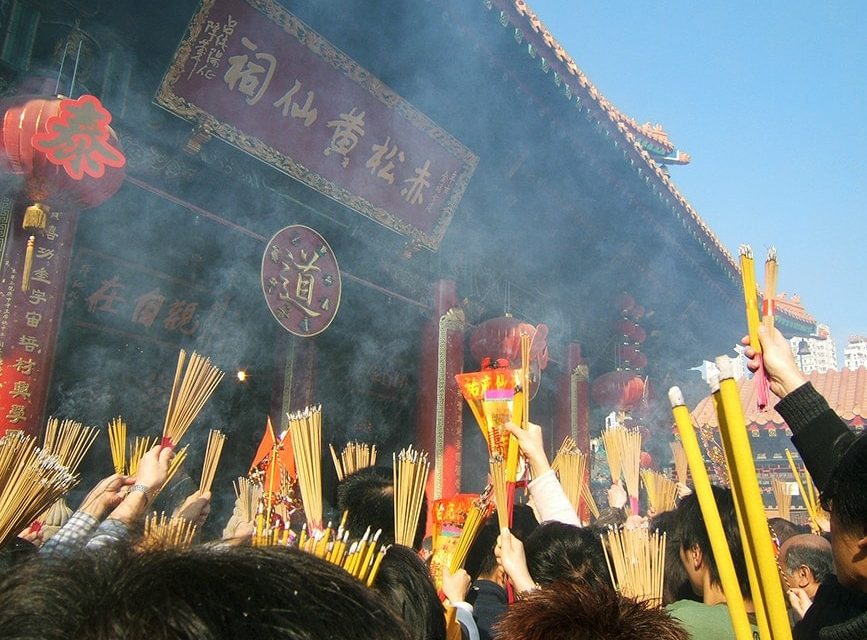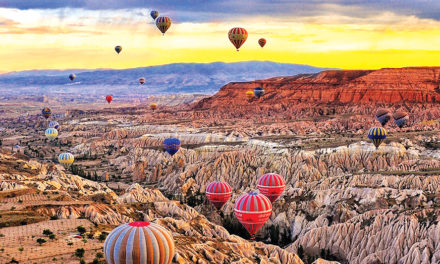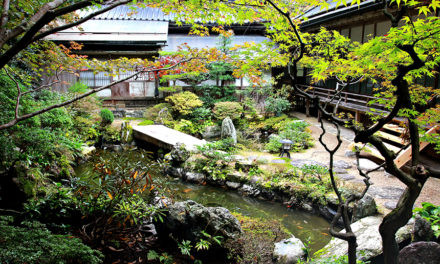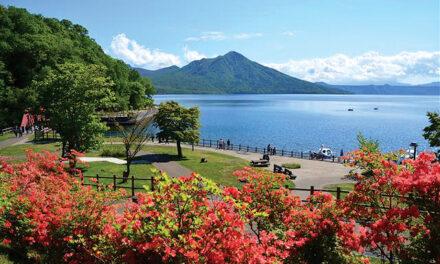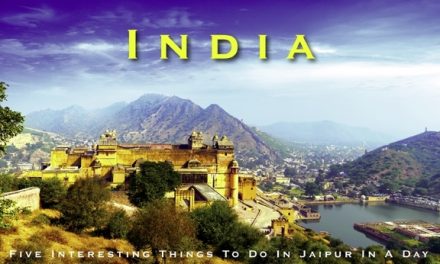Hong Kong
Celebrates Chinese New Year
Text & Photos: By Michael Morcos
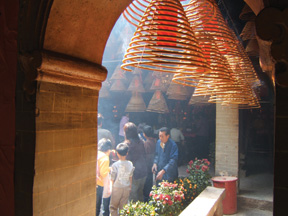 Hong Kong is considered by many to be Asia’s World City and it certainly is the one place in the Orient that a genuine world traveller would not want to miss, either as an exclusive destination or as part of a more extensive pan-Asian tour.
Hong Kong is considered by many to be Asia’s World City and it certainly is the one place in the Orient that a genuine world traveller would not want to miss, either as an exclusive destination or as part of a more extensive pan-Asian tour.
This is particularly true during the city’s exuberant annual celebration of Chinese New Year, which takes place in late January and early February. According to the Chinese Lunar Calendar, 2006 is the Year of the Dog. The traditional New Year’s greeting in Cantonese Chinese “Kung hei fat choi” is literally translated as “I wish that you will be prosperous.”
The 15-day celebration includes the eclectic mix of colourful parades, fireworks, banquets, fragrant floral and fruit-tree displays, religious rituals, taboos and superstitious beliefs. In stark contrast to the modernity of the city, these ancient traditions are universally adhered to by Hong Kong Chinese with such intense fervour that it makes our Western-style New Year festivities seem pale in comparison. But rest assured, Hong Kong, which means “Fragrant Harbour,” is fascinating at any time of the year.
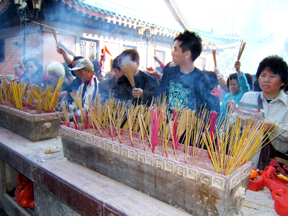 Getting There
Getting There
I was intrigued by the fact that my 20-hour Cathay-Pacific flight from Toronto included a short stop at Anchorage, Alaska. It was only after referring to a globe that I discovered that this is indeed the shortest route to Hong Kong, the alternative being the much longer flight across the vast Pacific.
The flight, although long, was made very comfortable, due in no small part to the amicable Cathay-Pacific flight attendants who served our in-flight meals and drinks with impeccable oriental efficiency and disarming charm. I also whiled away the time watching movies from the excellent selection available on my personal video centre installed in the back of the seat ahead of me.
Before I realized it, we had started our descent to Hong Kong’s ultramodern international airport, now voted the world’s best airport for five years in a row.
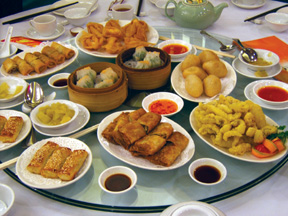 The Airport Express, a dedicated state-of-the-art airport railway, provides regular, fast and reliable service to downtown Hong Kong is about 24 minutes.
The Airport Express, a dedicated state-of-the-art airport railway, provides regular, fast and reliable service to downtown Hong Kong is about 24 minutes.
I checked into the impressive 42-floor, 800-plus-room Renaissance Harbour View Hotel. The hotel is built atop Hong Kong’s architecturally distinctive Convention & Exhibition Centre in Wanchai. Wanchai is the waterfront district of Central Hong Kong, located on the northwestern coast of Hong Kong Island.
The spectacular view from my room on the 31st floor was of the skyline of Kowloon, the northern part of Hong Kong, which along with the New Territories, is situated on the mainland across the city’s picturesque Victoria Harbour. However, it should be noted that all of Hong Kong boasts a wide variety of accommodations to suit even the most budget-conscious of visitors.
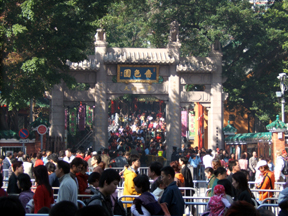 New Year’s Eve
New Year’s Eve
In the afternoon of my very first day in Hong Kong, I toured the Temple of Tam Kung, where locals celebrate the Tam Kung Festival. A patron saint of the sea, Tam Kung is said to bring security and happiness to all fishermen. Seafarers celebrate his birthday at the temple (usually in May) in order to secure their safety and good luck during the coming year.
My day continued with a visit to the bustling Flower Market in Victoria Park, where Hong Kongers were busy buying the blossoms, bamboo and pine sprigs, oranges, tangerines and assorted sweet dried fruits used to create the traditional elaborate New Year’s Eve decorations and the special offerings to guests, even in the humblest of homes.
At night, I was treated to a spectacular outdoor show called the Symphony of Lights during which the famous Hong Kong skyline and its harbour come alive with sound and lights. This show, the largest and best of its kind in the world according to the Guinness Book of World Records, takes place every evening at 8 p.m.
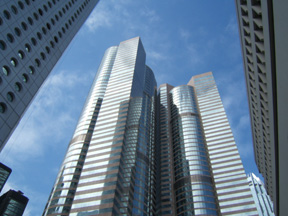 First Day of the Lunar New Year
First Day of the Lunar New Year
By the light of day, Hong Kong’s skyline is just as impressive as at night. Three of the world’s ten tallest buildings, including the landmark Bank of China Building, are located in Hong Kong. Once completed in 2008, the 118-floor International Commerce Centre, now being constructed in the Kowloon District, will become the city’s tallest building.
But to fully appreciate the dramatic topography of the city, one must ascend Victoria Peak, Hong Kong’s number one tourist attraction, which plays host to more than six million visitors each year. It features the city’s oldest and most reliable mode of public transport – The Peak Tram, in operation since 1888. The scenic ride up from the city centre to The Peak only takes 7 minutes.
At the summit, visitors arrive at The Peak Tower, the city’s most unusual building and icon. The unique “wok” shaped tower sits at an elevation of 396 metres. Viewing terraces, located on different levels of the tower, offer spectacular views of the Hong Kong and Kowloon skylines, with Victoria Harbour stretched out between them. The morning I rode up to the peak, the atmosphere above the city was a bit hazy, but the views were still spectacular.
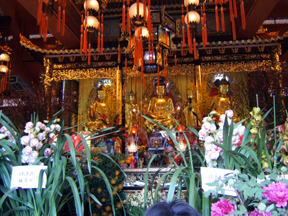 First Blessing of the Year
First Blessing of the Year
After enjoying a traditional Lion Dance in the hotel lobby, I made the pilgrimage to Sik Sik Yuen Wong Tai Sin Temple to witness “The First Blessing of the Year.” Located on the outskirts of the Kowloon District, the temple is packed with worshippers all year round, but it is especially busy at various festival times. On the eve of every Lunar New Year, worshippers queue for hours just to light up the first joss sticks of the New Year at midnight.
This ritual, believed to bring good luck for the coming year, continued unabated during my visit on New Year’s Day. The hoards of pilgrims also brought offerings of fruit and flowers for Buddha, along with their lit incense sticks. It was hot and the air was thick with smoke, but I revelled in this spontaneous explosion of joyous worship, even though I must have smelt like a camper after this memorable experience.
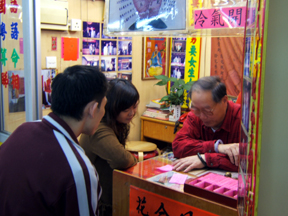 Another important aspect of the celebration of the New Year is to visit to one of the more than one hundred fortune-tellers, lined up at one side of the temple. For a small fee, these colourful seers tell pilgrims, as well as tourists through translators, what they can expect in the coming year. This mixture of religious fervour, tradition and superstition never failed to amaze me.
Another important aspect of the celebration of the New Year is to visit to one of the more than one hundred fortune-tellers, lined up at one side of the temple. For a small fee, these colourful seers tell pilgrims, as well as tourists through translators, what they can expect in the coming year. This mixture of religious fervour, tradition and superstition never failed to amaze me.
Night Parade
An unexpected treat was the Cathay Pacific International Chinese New Year Night Parade. That’s quite a mouthful to say, but the parade was quite interesting. Participants hailed from such diverse countries as Japan, Italy, Mexico and Canada, which was proudly represented by a contingent of RCMP officers in full Mountie regalia!
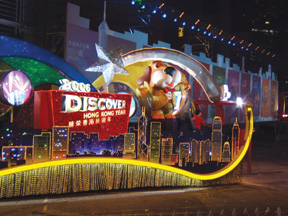 Exploring Lantau Island
Exploring Lantau Island
Lantau is the largest of the outlying islands of Hong Kong. Lying due east of Hong Kong Island, Lantau is almost twice its size. However, more than half of the island has been designated as a Country Park.
Its tranquil and green environment makes it a popular spot for nature lovers and hikers. Honk Kong’s new international airport, glimpsed in the distance to the north on its own island and connected to Lantau by a bridge, is in stunning contrast to the peaceful charm of this idyllic rural area.
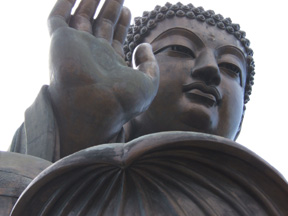
Giant Buddha and Martial Arts
The 34-metre-high Giant Buddha, located at Ngong Ping on Lantau Island, is the world’s tallest, outdoor, seated, bronze Buddha statue. It sits on a lotus throne above a three-metre platform altar and weighs 202 tonnes.
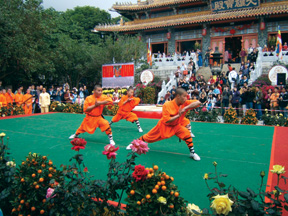
At the nearby Po Lin Monastery, set amid spectacular mountain scenery on the 520-metre-high Ngong Ping plateau, I was treated to a riveting display of martial arts preformed by monks from Mainland China dressed in their traditional bright, saffron-coloured outfits. To cap it all off, I savoured a delicious vegetarian meal at the monastery’s spacious restaurant.
Tai O Fishing Village
Tai O is located just west of Lantau Island. Dubbed the Venice of Hong Kong, it is one of the city’s most famous outlying islands. It is special not only for its traditional fishing village, but also for its unpolluted rural lifestyle. Most of the tiny population of Tai O are fishermen. In the past, they earned their money chiefly by fishing and the salt industry, providing a wide variety of marine products such as fresh and salted fish; shrimp and shrimp paste; and squid for Hong Kong’s ever-demanding markets.
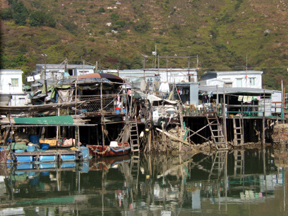 Today however, the people in Tai O earn their income mainly by tourism, even though they have managed to maintain their centuries-old customs. Most families in Tai O own a boat because the principal means of transportation is still by water.
Today however, the people in Tai O earn their income mainly by tourism, even though they have managed to maintain their centuries-old customs. Most families in Tai O own a boat because the principal means of transportation is still by water.
Their houses are called ‘pangwu’ or ‘stilt houses’, because of the style of their construction. Originally made of wood and leaves, ‘stilt houses’ are now built with wood and metal sheets. A visit to Tai O takes you temporarily away from the hustle and bustle of Central Hong Kong and transports you to a simpler and more serene time in the city’s long history.
Back in Central Hong Kong, New Year celebrations continued unabated for a second night and were quite literally going off with a bang, as one of the most impressive fireworks displays I have ever witnessed exploded in long, colourful bursts over the city’s harbour.
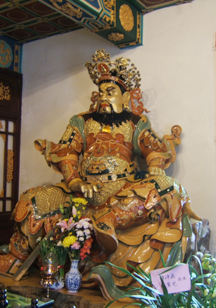 The General’s Wheel of Fortune
The General’s Wheel of Fortune
As in most former rural centres in the New Territories, located north of Kowloon, Sha Tin features a range of temples with a rich history. Perhaps the most unusual of these is the Che Kung Temple in the Tai Wai area, which looks more like a Japanese shrine than a traditional Chinese temple. Today, the temple is housed in a modern building (completed in 1993), which stands in front of the original temple, built more than 300 years ago.
The temple is dedicated to Che Kung (General Che), a great soldier who achieved fame by putting down a rebellion in South China during the Sung Dynasty (AD 960-1279). He is said to have accompanied the Emperor when he fled south to Hong Kong before the fall of the Sung Dynasty. After his death, Che Kung was raised to the status of a deity because he had saved the inhabitants of the Sha Tin Valley from an outbreak of the plague.
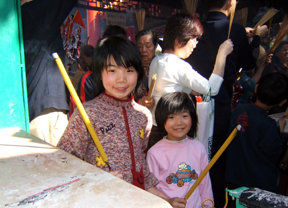 On the third day of the Lunar New Year, the day I visited the temple, crowds of worshippers flocked there to wish Che Kung happy birthday and to venerate his giant statue located in the main worshipping hall. Next to his statue was a fan-bladed wheel of fortune, which I couldn’t see because of the crowds, but which worshippers believe brings them good luck when turned three times.
On the third day of the Lunar New Year, the day I visited the temple, crowds of worshippers flocked there to wish Che Kung happy birthday and to venerate his giant statue located in the main worshipping hall. Next to his statue was a fan-bladed wheel of fortune, which I couldn’t see because of the crowds, but which worshippers believe brings them good luck when turned three times.
Horse Racing at Sha Tin
Chinese business know-how is world-renowned, mostly for its sheer audacity in taking risks and this seems to have translated itself into the leisure activities of Hong Kong residents. This explains why horseracing is such a popular local sport. But I also discovered on my visit to the Sha Tin Racecourse in the New Territories on the 3rd day of the New Year, that it is customary on this day for Hong Kongers to go to the races to avoid any arguments with family members, which could result in bad relations during the entire coming year!
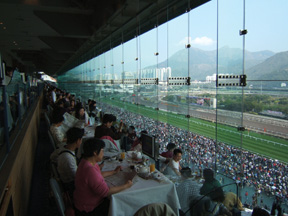 Hong Kong’s original, highly successful racecourse Happy Valley was built in1846 on Hong Kong Island. The surplus revenue it created over the years was used to build the second racecourse at Sha Tin in 1978.
Hong Kong’s original, highly successful racecourse Happy Valley was built in1846 on Hong Kong Island. The surplus revenue it created over the years was used to build the second racecourse at Sha Tin in 1978.
Today, Sha Tin is one of the best and most exciting racetracks in the world, seating up to 85,000 enthusiastic Hong Kong fans and visitors from around the world. Incidentally, the equestrian events of the 2008 Beijing Olympics will be held in Hong Kong because of its superior horse-riding facilities.
Yuen Long’s Walled Villages
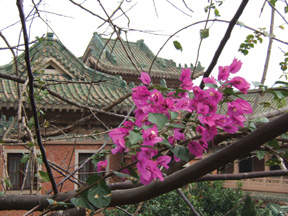 The Yuen Long District in the northwest New Territories lies at the centre of Hong Kong’s largest alluvial plain. To some, Yuen Long conjures up pictures of a busy main street; the fast-growing new town area of Tin Shui Wai; and the district’s finely constructed, secluded period mansions. However, beyond these modern-day developments are the area’s fascinating ancient walled villages and important historic monuments.
The Yuen Long District in the northwest New Territories lies at the centre of Hong Kong’s largest alluvial plain. To some, Yuen Long conjures up pictures of a busy main street; the fast-growing new town area of Tin Shui Wai; and the district’s finely constructed, secluded period mansions. However, beyond these modern-day developments are the area’s fascinating ancient walled villages and important historic monuments.
Kat Hing Wai in Kam Tin is one of the district’s best-known walled villages. It is the ancestral home of the Tangs, a famous clan of the territories. Built by the family 500 years ago, it served the Tangs well over the centuries. In the Kang Xi Era of the Qing Dynasty, when bandits were a menace, a five-metre high blue brick wall and four cannon towers were added to the village to fend off invaders.
Inside Kat Hing Wai, traditional village houses are neatly arranged and separated by narrow lanes, some of the houses dating back to the Qing Dynasty. Over the years, the village has seen the addition of several more modern villas. Some say these modern structures ruin the old village charm, while others say this case of “East meets West” adds a new and welcome dimension to the village.
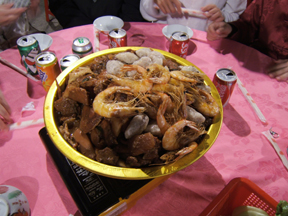 Big Bowl Feast
Big Bowl Feast
Poon Choi (Big Bowl Feast) is a dish served in wooden basins rather than in the usual porcelain or metal bowls. It has become so popular that many Hong Kongers and visitors alike travel to Yuen Long and other historic New Territories districts specifically to savour this age-old delicacy.
The Poon Choi tradition, which is particularly popular during New Year and other festival times, dates back to the late Sung Dynasty (AD1270s), when the Yuen army invaded China and the imperial family was forced to flee south to Hong Kong. Villagers in the New Territories had to use big wooden basins to serve the imperial entourage, as they could not find enough large porcelain or metal containers to serve the elaborate dish.
The emperor was doubtlessly satisfied with his meal, but it certainly couldn’t compare with today’s Poon Choi, which often includes layers of pork, beef, lamb, chicken, duck, abalone, ginseng, shark’s fin, fish maw, prawn, crab, dried mushroom, fish balls, squid, dried eel, dried shrimp, pig’s skin, bean curd and radishes. This exotic dish, meant to be eaten in layers, not stirred, is perhaps a bit challenging for the uninitiated, but definitely worth a try, as I discovered in the Ping Shan Ancestral Hall dining room in Yuen Long!
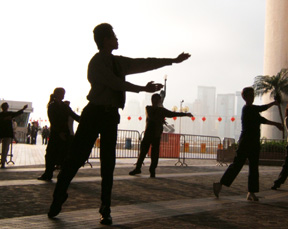 Tai Chi Class
Tai Chi Class
Early in the morning of my fifth day in Hong Kong, I participated in my first Tai Chi class held by the city’s waterfront. Sometimes called “Shadow Boxing”, Tai Chi balances the Yin and the Yang, doing as much for the mind and soul as for the body. The graceful and leisurely-looking movements are a favourite means of keeping fit in Hong Kong, especially among the city’s golden-agers.
This is part of the popular Cultural Kaleidoscope Program offered free to visitors, who can also join other classes on Chinese tea appreciation, antique Chinese furniture, pearl and jade grading and traditional Chinese clothing, as well as sessions that demystify “feng shui” and Chinese martial arts.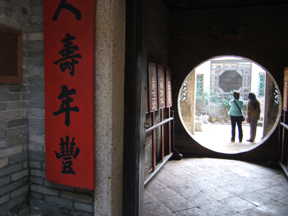
By the way, feng shui is very important to the Chinese in the design and positioning of everything from their furniture and their homes to those of public places and even high-rise commercial buildings. It can mean the difference between success and failure. The phrase translates as “the way of Wind (feng) and Water (shui)” or “the natural forces of the universe.” According to the Chinese, everything in one’s life should conform to the scheme of these powerful forces.
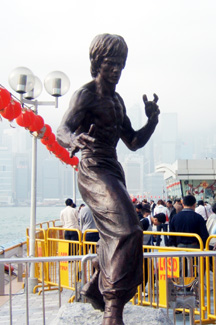
Avenue of Stars
Fans of Hong Kong-made movies should take a stroll, as I did, along the Avenue of Stars on the Tsim Sha Tsui promenade. This attraction, the first of its kind in Asia, pays tribute to Hong Kong stars of the silver screen, including actual handprints of stars such as Jackie Chan and Jet Li. The latest addition to the avenue is a two-metre-tall bronze statue of the legendary kung-fu action star Bruce Lee, who was named “Star of the Century” by the HK Film Awards Association in 2005, the 65th anniversary of his birth.
The Avenue also offers incredible panoramic views of the city’s famed Victoria Harbour and the stunning Hong Kong skyline. It is also the perfect spot to watch the previously mentioned nightly Symphony of Lights show.
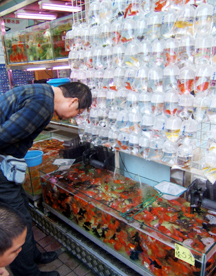 After my stargazing experience, I visited a goldfish market with its incredible arrays of every imaginable variety of goldfish. Next, was a jade market where vendors were selling all sorts of rings, bracelets, pendants and statues, all intricately hand-carved, at amazingly affordable prices.
After my stargazing experience, I visited a goldfish market with its incredible arrays of every imaginable variety of goldfish. Next, was a jade market where vendors were selling all sorts of rings, bracelets, pendants and statues, all intricately hand-carved, at amazingly affordable prices.
Of Temples & Wishing Trees
In 1984, the Man Mo Temple, located on Fu Shin Street in Tai Po, became the first structure in the New Territories to be declared a national historic monument. The Tsat Yeuk villagers built it in 1891 and their present-day descendants go there for reflection, or to seek guidance and peace and ask for blessings for their loved ones and themselves.
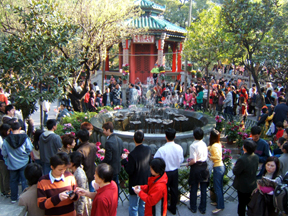 Built in the style of a centralized walled compound, the temple emphasizes seclusion. Inside the building, the main hall is used for the worship of two Taoist deities from the Warring States Period (403-221 BC): the God of Literature (Man) and the God of War (Mo).
Built in the style of a centralized walled compound, the temple emphasizes seclusion. Inside the building, the main hall is used for the worship of two Taoist deities from the Warring States Period (403-221 BC): the God of Literature (Man) and the God of War (Mo).
After touring the Man Mo Temple, I made a delightful stop at one of the Wishing Trees that stand outside the Tin Hau Temple in the Lam Tsuen area of Tai Po. Famous throughout China, these two banyan trees, are a favourite with local villagers and the many Hong Kongers who make a special New Year pilgrimage to burn joss sticks and incense papers in front of the trees, all hoping their New Year wishes will come true.
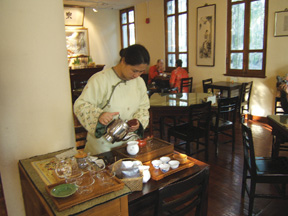 Lock Cha Teashop
Lock Cha Teashop
Back in the heart Hong Kong, I visited a traditional teashop called Lock Cha, which translates as “the pleasure of, or love of tea.” The surrounding office towers dwarfed the tiny shop. Here I learnt that there are six colours of tea: one for each colour of traffic lights (green, orange and red); two for yin and yang (white and black); and one green/orange colour of unspecified significance.
Not only did I enjoy sipping tasty tea in an English-style setting, I also learnt about its many varieties, its proper preparation and the rudiments of the age-old etiquette of tea-drinking. A visit to Lock Cha, included in the free Cultural Kaleidoscope Program, makes you see for yourself why the ancient Chinese saying holds true: “Life is like tea. The longer it steeps, the richer it becomes.”
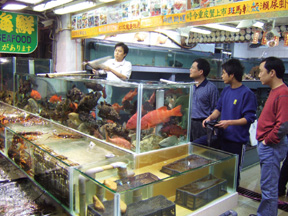 A Seafood Feast
A Seafood Feast
Known as “Hong Kong’s Garden”, the rugged Sai Kung peninsula and its islands that lie along the southeastern coast of the New Territories, are remarkably only a few miles east of bustling Kowloon. The district, characterized by its Mediterranean-style low-rise houses and villas, offers locals and visitors alike a wealth of sightseeing spots; secluded beaches; water sports centres and a wide variety of first-rate restaurants.
On the evening I visited a seaside fish market in Sai Kung, fresh local catches were being sold from a dockside fishing boat. The overwhelming choice was from its offering of fresh lobsters, shrimp, scallops and a myriad of other exotic fish and seafood. An upstairs waterfront restaurant cooked my selection of lobsters to my liking while I waited in breathless anticipation. What a scrumptious meal that was for the avid local and visiting seafood lovers, who dined in large groups, both inside and outside the restaurant!
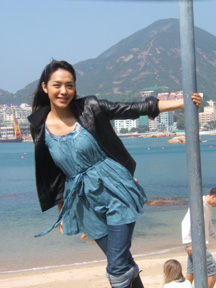 Stanley Beach & Market
Stanley Beach & Market
A great independent mini-excursion on Hong Kong Island is to take a bus across the island to Stanley, which lies on the southern coast that faces the South China Sea. The morning bus ride I took only lasted about 20 minutes but the views were breathtaking, as most of the route hugged the rugged cliffs that bordered the legendary sea.
The scenery reminded me of the French Riviera on the Côte d’azur. Equally stunning were the houses of well-to-do Hong Kongers and the tall luxury apartment buildings, which were built on steep embankments overlooking the area’s picturesque coves and beaches.
I was fortunate to meet local actress-model Ella (who appears on the cover of the Spring 2006 Issue) and her manager while they were doing a photo-shoot for Jaguar automobiles right there on legendary Stanley Beach. Like all of the other Hong Kongers I met on my trip, she readily agreed to let me take a few pictures of her and publish them in this magazine.
Stanley has the feeling of an English seaside town, a legacy of its rich colonial past, which the locals openly celebrate rather than resent. There are lots of English-style pubs and restaurants along the beach, but the town is foremost a shopper’s paradise. Its huge open-air market sells traditional handicrafts, paintings and sculpture, Chinese costume jewellery and beautiful silk articles, at very reasonable prices. The market alone makes it definitely worth the half-day or so it takes to visit Stanley.
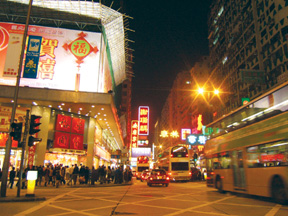 The Golden Mile
The Golden Mile
After returning to my hotel in Central for a brief rest, a shower and a change of clothes, I took the ferry across the harbour and walked up Nathan Street, located in the heart of Kowloon’s shopping district. Nathan Street is justifiable called The Golden Mile of Hong Kong. This busy, broad avenue, that runs north from Kowloon’s waterfront, is lined with a kaleidoscope of shops and restaurants.
The flashing neon-lit signs on either side of the street almost turned night into day. Camera and electronics stores were everywhere, as were shops selling clothing, luggage, souvenirs, and anything else you could think of. For even the most determined non-shopper, Nathan Street is definitely worth an evening’s leisurely stroll.
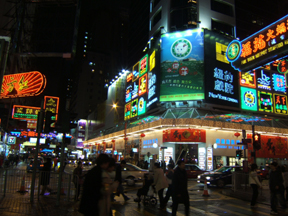 Temple Street Night Market
Temple Street Night Market
After my walk along Nathan Street, I felt I had to take a side trip to Hong Kong’s most famous open-air night market, located on Temple Street just off Nathan Street in Kowloon. It opens at 2 p.m. every day but really only comes to life at dusk. Its astounding array of stalls sells everything from watches and leatherwear to sports apparel and souvenirs.
After perusing some of the enticing merchandise on display, I decided to indulge in a quick meal at one of the market’s many outdoor restaurants and was pleasantly surprised to find that my selection of a tasty noodle and vegetable dish, plus a large beer, only cost me $5.00 Canadian, which included a generous tip!
Life-Size History
On my second-to-last day, I visited the impressive and very comprehensive History Museum, which vividly portrays Hong Kong’s storied past. Exhibits, some of them life-size replicas of entire scenes, follow the city’s growth and development from a tiny fishing village, to a British Crown Colony, to its present-day status of as a modern world-class Chinese metropolis. If you visit only one museum in Hong Kong, make it this one.
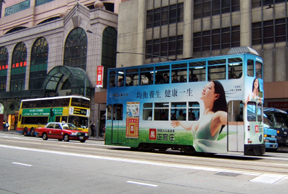 My Little Red Book
My Little Red Book
In the afternoon, I decided to take the self-guided Central & Western District Walk following the excellent illustrated guide published by the Hong Kong Tourism Board. Along the way, I meandered through the Antique Market on Hollywood Road, where I haggled for and bought a genuine antique copy in the original Chinese of the famous “little red book” entitled The Thoughts of Mao Tse-Tung.
Along this interesting and well-thought-out route, I also visited the famed herbal medicine shops on Ko Shing Street; strolled through Hong Kong’s colourful SoHo District located south of Hollywood Road and famous for its great cafes and funky bars; and rode the world’s longest covered escalator. At 800 metres long, the escalator is a convenient and inexpensive way to view the bustling hillside cityscape that lies below its elevated platform.
A Honk Kong Farewell
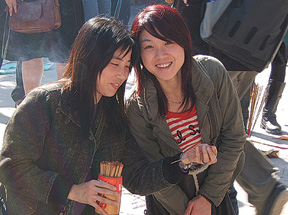 In the morning of my last day in this remarkable city, where “East meets West” is an everyday occurrence, I walked through the Wan Chai area just south of my hotel. This area was actually Hong Kong’s waterfront before additional land was reclaimed in 1921 from Victoria Harbour.
In the morning of my last day in this remarkable city, where “East meets West” is an everyday occurrence, I walked through the Wan Chai area just south of my hotel. This area was actually Hong Kong’s waterfront before additional land was reclaimed in 1921 from Victoria Harbour.
That morning, as is normal, the area was crowded with people and the roads were busy with traffic, but the pedestrians and drivers were unbelievably courteous, patient and friendly to each other, unlike in many other large cities.
The same was equally true on all modes of Hong Kong’s excellent public transit system, from the efficient and spotless subway system and the numerous London-style double-decker buses to the very affordable easy-to-find taxis and the ferryboats that crossed the harbour at regular intervals.
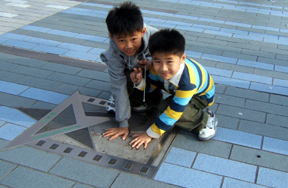 On my return Cathy-Pacific flight, which seemed a breeze at only 17 hours, I couldn’t help thinking of the pleasant, polite and always helpful people of Hong Kong.
On my return Cathy-Pacific flight, which seemed a breeze at only 17 hours, I couldn’t help thinking of the pleasant, polite and always helpful people of Hong Kong.
The authorities of the People’s Republic of China had obviously recognized a good thing when Hong Kong was amicably handed over by the British in 1997. The new administration wisely decided to leave almost everything wonderful that Hong Kong has to offer to the world intact, and for this, avid world travellers can truly by thankful.
On my recent trip, I felt that I had travelled both into the past and into the future, at the same time and in the same place, in fascinating, tradition-bound but ever-evolving Hong Kong.

